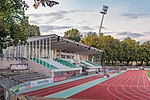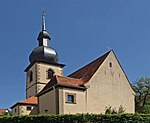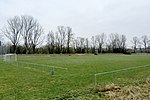1. FC Schweinfurt 05
1. Fussball-Club Schweinfurt 1905, Verein für Leibesübungen e.V., called 1. FC Schweinfurt 05, Schweinfurt 05, or simply FC 05, is a German association football club established in Schweinfurt (Bavaria) in 1905. It has sections for netball, fistball, field hockey, badminton, gymnastics, rugby, American football, futsal, and athletics. The club is well known due to successful years in top and second-tier football leagues from the 1930s to the 1970s, and thanks to outstanding individuals. During the late 1930s, Schweinfurt's midfielders Albin Kitzinger and Andreas Kupfer, today considered as two of the best half-back players of all time, formed the core of the Germany national football team and represented their country at the 1938 FIFA World Cup and within the premiere FIFA continent selection Europe XI.The FC 05 first team, which competes in the tier-four Regionalliga Bayern since the 2013–14 season, is organized within 1. FC Schweinfurt 1905 Fußball GmbH. The club plays its home games at Sachs-Stadion in Schweinfurt.
Excerpt from the Wikipedia article 1. FC Schweinfurt 05 (License: CC BY-SA 3.0, Authors).1. FC Schweinfurt 05
Kasernenweg,
Geographical coordinates (GPS) Address Nearby Places Show on map
Geographical coordinates (GPS)
| Latitude | Longitude |
|---|---|
| N 50.051277777778 ° | E 10.203027777778 ° |
Address
Kasernenweg
97424 , Musikerviertel
Bavaria, Germany
Open on Google Maps









